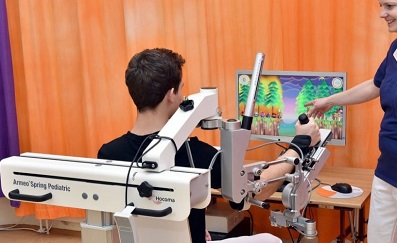Interview: Robot-assisted therapy in neurology at Helios Klinik Hattingen
Hocoma
Michael Klein, Therapy Management and Planning Services at Helios Klinik Hattingen, was recently interviewed by Medica about the benefits of using robotics for neurological rehabilitation. Read the full article here.
It takes consistent repetitions if rehab patients want to relearn skills after surviving a stroke. This requires extreme effort. The industrial sector uses robots to perform repetitive tasks or handle jobs that require strength. What has been a fixture in factories for decades is now also making its way into rehabilitation facilities.
Mr. Klein, your clinical facility offers robot-assisted therapy. What does this look like?
Michael Klein: It means we use electromechanical devices to train patient motor functions. This equipment supports mobilisation purposes, assists gait training and helps to improve arm and hand function. The therapy is chiefly based on the patient’s impairment and treatment goal. We are a neurology clinic, which means our patients often suffer from disorders of the nervous system related to a stroke or traumatic brain injury or they have suffered incomplete spinal cord injuries. We treat patients who need to relearn how to walk or recover upper extremity movement. The use of equipment is subsequently based on the pathology and treatment goal.
What kind of equipment do you use in your clinic?
Klein: We use devices made by Hocoma. We have two Lokomat therapy devices available in our facility. The Lokomats are robotic devices made for gait training and gait rehabilitation. We use our two Erigo devices to treat patients who require more acute care. We apply the Armeo therapy concept to train the upper extremities. One of these devices is specifically designed for paediatric patients. We also have an Andago device, a mobile robot for functional gait therapy.
What are the benefits of these specific rehabilitation devices?
Klein: These devices simply offer unique options in terms of gait training or general motor skill rehabilitation. You have to think of it this way: When we walk, we don’t have to think about how we make the next step and where we are going to put our foot down. This happens automatically because we learned how to walk when we were little children. When it comes to our patients, this program- as it were- has been partially removed. Patients can no longer access it after a stroke or traumatic brain injury. That’s why the program must be partially rewritten. This means that the movements must be relearned through massed practice and repetition of exercises – at least several hundred if not thousands of times. We cannot achieve this through hands-on or manual therapy. If patients who are unable to walk must practice thousands of steps, we need devices or machines that can offer support. The Lokomat is powered by four electric motors, two of which are placed in the hip and two in the knee area of the patient. The electromechanical unit has integrated sensors that give us feedback about the patient’s capacity and ability. This allows us to adapt the robot and the intensity of movements to match the patient’s needs.
In what way is robot-assisted physical therapy more effective than manual therapy?
Klein: Patients can achieve their goals faster with robot-assisted therapy. In other words, robots speed up the rehabilitation process and recovery. They are a powerful tool for physical therapists and are able to challenge patients to embark on more intensive training that might not be achieved with a manual approach. The way these devices are controlled is yet another aspect that shouldn’t be underestimated. In the case of the Armeo device, for example, patients are immersed in a virtual, interactive environment where they can use their affected arms via the controls. Needless to say, this type of motivation is a key factor in achieving therapy goals.
What’s your take? Will robots soon fully replace human beings in the medical field?
Klein: Needless to say, I am unable to predict the future but I personally don’t think this is going to be the case. We need expert knowledge that tells robots what to do. Of course, we don’t know how fast artificial intelligence is going to progress and what things will look like ten years from now. It’s highly likely that there will be some machine intelligence systems that can also make decisions. Having said that, I still believe that we will always need human beings – and in our case therapists – with the respective knowledge and skills to use the equipment. In our facility, the robot doesn’t replace a staff member, but the staff member utilises the robot to speed up the patient’s rehabilitation process and recovery.
You can read more about Hocoma‘s products here. Find out more about Helios Klinik Hattingen here. Medica is the leading international trade fair for medicine and healthcare, read more.

